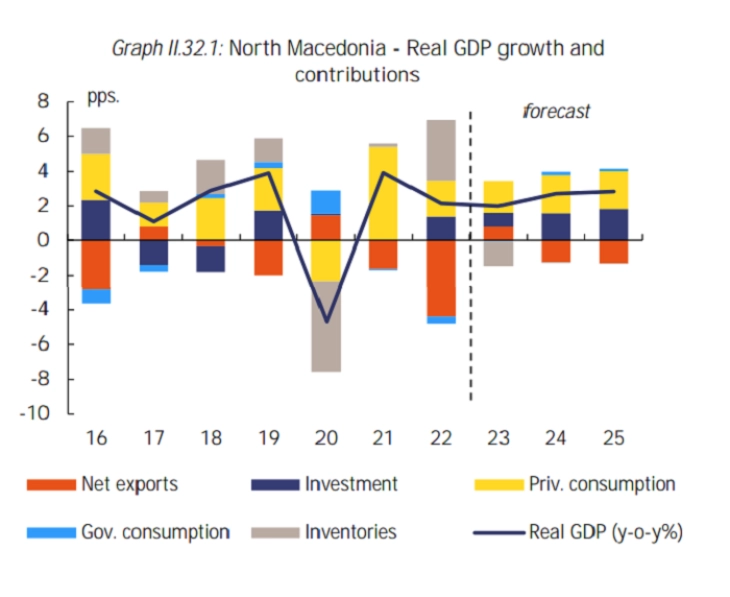EC projects domestic demand to remain key driver of North Macedonia’s GDP growth
- After a muted post-pandemic recovery, economic growth has slowed down on account of both weaker external demand and more moderate household consumption. Growth is set to accelerate moderately ahead, with inflation expected to mitigate further, wage growth and remittances, projects the European Commission in its Autumn 2023 Economic Forecast on North Macedonia.

Brussels, 15 November 2023 (MIA) – After a muted post-pandemic recovery, economic growth has slowed down on account of both weaker external demand and more moderate household consumption. Growth is set to accelerate moderately ahead, with inflation expected to mitigate further, wage growth and remittances, projects the European Commission in its Autumn 2023 Economic Forecast on North Macedonia.
MIA’s Brussels correspondent reports that, according to the EC, in the coming period domestic demand is projected to remain the key driver of the expected acceleration in the country’s GDP growth.
At the same time, the fiscal deficit is expected to remain elevated, given new spending commitments and high borrowing costs, restraining the decline of public debt from its post-COVID high.
The European Commission notes that in the second quarter of 2023, real GDP rose by 1.1 percent annually, but dropped by 2.1 percent compared to the preceding quarter.
According to the EC, household consumption has suffered from the lingering cost-of-living crisis and its growth decelerated for the third consecutive quarter, to 1.6 percent annually, but, the EC says, it has remained the main driver of GDP growth. “It is expected to firm as disposable incomes strengthen on account of faster real wage growth amid falling inflation,” says the EC in its Forecast.
The Forecast states that investment was muted in the first six months of 2023, as private companies dealt with their large inventories built up in 2022.
“In the first half of 2023, the current account deficit declined markedly from its 2022 high, as the goods trade balance improved on account of decreasing energy prices, and remittances increased. Looking ahead, both import and export growth are set to pick up gradually,” notes the EC.
The Commission also highlights the fact that the low and declining labor market participation, especially for women and young workers, has led to a further shrinking of the labor force and a decline in the unemployment rate.
“During the forecast horizon, employment is expected to continue growing at a moderate pace. While employment growth in manufacturing industries is likely to remain muted at least in 2023, given a large backlog of inventories weighing on current production activity, the services sectors, in particular trade, are likely to account for the bulk of job expansion,” notes the Forecast.
According to the EC, annual consumer price inflation has gradually declined from its peak of 19.8 percent in October 2022 to 6.6 percent in September 2023. The Commission projects the inflation to remain high, around 9 percent on average in 2023, but to eventually ease to the long-term average of 2 percent by 2025.
“The central bank increased the key policy rate further in the first nine months of 2023, yet at a slowing pace, to reach 6.3 percent in September,” adds the Commission.

The document notes that public finances are strained by high borrowing cost and new spending commitments, even though, it says, a budget reallocation in September managed to accommodate the additional expenditure without raising the full-year deficit target.
“The government raised the minimum pension, and agreed to an additional 10 percent increase in public sector wages as of September, which adds some 0.2 percent of GDP to projected current expenditure for 2023,” states the EC.
The EC also assesses amendments to the personal, corporate and value-added tax laws as “revenue-enhancing”, and notes the one-off solidarity tax which, it says, is expected to add an extra 0.6 percent of GDP to 2023 revenue.
“Overall, the general government deficit is projected to increase somewhat in 2023 compared to 2022. Assuming that the government implements planned fiscal consolidation measures, including the phasing out of energy subsidies, the fiscal deficit is set to decline gradually in 2024 and 2025, but to remain well above the pre-pandemic level of 2.2 percent of GDP in 2019,” states the Forecast.
The EC projects government debt to hover above 50 percent of GDP in the medium-term, as primary deficits remain elevated and interest payments are rising.
“The growth outlook could be challenged if the major public roads construction project faces significant implementation delays. The fiscal outlook might also deteriorate if this project suffers from serious cost overruns, or if the cost of financing rises faster than projected,” assesses the EC.
The Commission also notes that the political uncertainty in the run-up to the 2024 elections could negatively impact the growth and fiscal outlook.
“On the upside, EU accession negotiations may accelerate structural reforms, which would raise the economy’s growth potential and bolster fiscal sustainability,” concludes the Forecast.
Photo: EC







